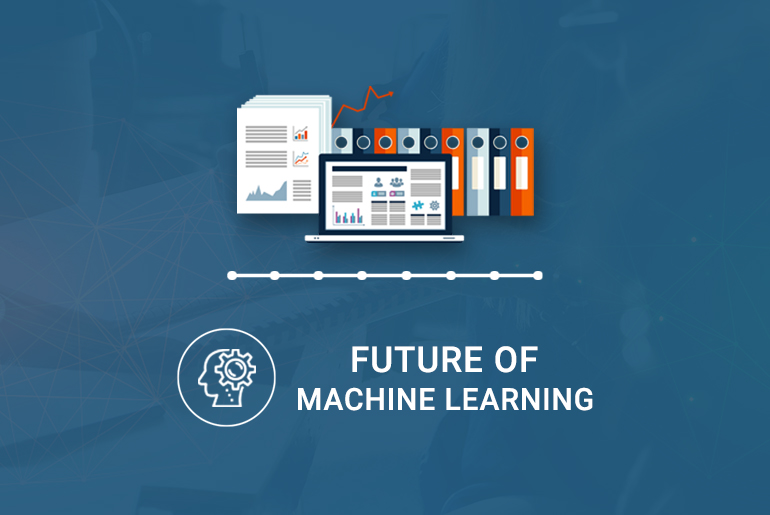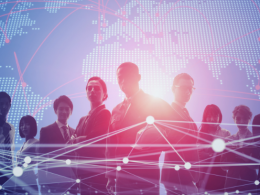Machine learning (ML) is the process which enables a computer to perform something that it has not been explicitly told to do.
Hence, ML assumes the central role in making sentient machines a reality.
With the launch of Sophia, an AI robot developed by Hanson robotics, we wonder how close we are to be outclassed by these smart fellows.
If you are speculating about the future of machine learning in the next ten years, this article by Accredian Research team will give you the answer!
Let’s get going.
Where is Machine Learning now?
Machine Learning today is automating everything.
With the of use of BigData framework in the mainstream applications, smart algorithms can now crunch this colossal repository of both static and dynamic data and continuously learn and improve its efficiency.
ML experts are moving away from abstractions and theorizing to focusing on business applications of AI powered by machine learning & Deep Learning.
ML is being increasingly applied in preventive healthcare, medicine, banking, finance, marketing, and media.
Considering the unscathed continuance of previous five years, ML isn’t slowing down anytime soon.
The ML Hype
Among significant breakthroughs in ML, Google recently open sourced its machine learning project Tensorflow, which is already a very active project being used for drug discovery to generating music.
While Microsoft open sourced CNTK, Baidu announced the release of PaddlePaddle and Amazon announced to back MXNet in their new AWS ML platform.
Facebook, on the other hand, is mainly supporting the development of not one, but two Deep Learning frameworks: Torch and Caffe.
Google is also supporting the highly successful Keras.
This hype is centered around the idea that algorithms and machine learning are going to take center stage in the tech world for a long time.
Talent demand supply gaps in machine learning have become steeper and platform wars have become fiercer.
What does Machine Learning & AI mean for your career?
In the coming ten years, AI applications will become more commonplace than ever.
Therefore all service providers will need to seriously upgrade both their hardware (storage, backup, computation power, etc.) and software (servers, networks, ad-hoc networks, etc.) capabilities.
Just like the parallel processing capacity provided by GPUs have made the current AI possible and viable, the computation power would need serious amp up to accommodate what’s coming. All sections of the technological workforce will come under immense pressure to enhance and invent.
Machine learning today is being used in mobile applications, image recognition systems, pattern recognition applications, filtering tools, robotics, etc.
Now, scientists are currently trying to develop a working machine that follows the exact processing that human brain does.
If we mapped every node and neural network of our brain and fed data to it, the system should be able to process data like a human brain.
This concept is called cognitive computing.
Cognitive computing systems will hence use pattern recognition, natural language processing, data mining to teach itself the thought process of a human being.
With their end goal being a sentient AI machine, these systems should garner a lot of attention in the coming years.
Cognitive Learning vs. Deep Learning: Where does the future lie?
Deep learning is a process employed to help the system learn from unstructured or unlabeled data, all the while being unsupervised.
Whereas, cognitive computing will use well structured and segmented data to train and test the model sentient machine, deep learning employs data mining and data processing techniques to scale according to the data, model the data better and make it useful to other machines.
Deep learning also uses neural networks but in combination with the enormous IoT data repositories, the scale, and type of processing differentiates it from cognitive learning.
Deep learning’s major application will be in the systems at the back end, systems that will contribute more towards marketing, branding, creating a database for other machines to learn from.
With IoT, deep learning systems will create a data mine that will be the spine of most intelligent systems.
While cognitive computing systems will work in collaboration with deep learning trained systems and IoT to perform the mainstream tasks in fields like Healthcare, medicine, scientific research and hypothesis testing, self-driving cars (automation), lip reading from video input and ultimately the sentient computing machine.
At Accredian, we believe two fields- ML and AI,-will grab much of the focus.
Now, a sentient machine might be far-fetched but the importance of machine learning in healthcare, cloud systems and marketing cannot be overestimated.
Stronger efforts to automate all routine parts of healthcare like testing for contaminants (viruses, bacteria, other foreign particles) in samples, detecting cancerous growths, examining x-rays and scans for exact issues,which might escape the attention of the doctor or practitioner,will be made.
Even as of now, some hospitals in developed countries like the USA, the UK, European nations are adopting AI options. More institutions and universities will invest in this field, and the demand will multiply manifold.
Trends to come:
The Hype Cycle for emerging technologies 2017 puts Machine Learning in the PIE section (Peak of inflated expectations) and the ‘AI Everywhere’ column.
We must, however, not be discouraged by the forthcoming trough of disillusionment. This is the time when significant innovations will made in this field.
Hence, shortly, we will probably see many more failed initiatives and broken aspirations.
But these innovations will catapult us into the golden age of AI and ML.
In the coming ten years, AI applications will become more commonplace than ever, and therefore all service providers will need to seriously upgrade both their hardware (storage, backup, computation power, etc.) and software (servers, networks, ad-hoc networks, etc.) capabilities.
Just like the parallel processing capacity provided by GPUs have made the current AI possible and viable, the computation power would need a serious boost to accommodate what’s coming.
All sections of the technological workforce will come under immense pressure to upgrade and invent
Upcoming professional opportunities
Not only technologies but many professions and opportunities will also rise with the advent of AI and ML.
There will be a surge in demand for data scientists, AI/Machine Learning engineers, Data Labeling Specialists, AI hardware specialists and Data Security Professionals.
The current workforce will need to provide these specialists, and only those who adapt quickly will stay.
As with all new professions, these fields will be unpredictable and demanding. Let’s look into some of these roles that, we at Accredian believe, will increasingly become mainstream in next 10 years.
1. Data Scientists: Think of a data scientist as the master of all trades related to data analysis and processing.
A data scientist is expected to be, as SAS put it, “part mathematician, part computer scientist, and part trendspotter.”
For example, Amazon Prime uses the previous watchlist of a person to suggest new shows.
The relationship between previously watched shows and next watchlist is developed by Machine Learning experts & Data scientists.
At e-commerce websites like Flipkart, the customer is presented with options in the same budget range if they are looking for a mobile phone.
Developing these correlations, segmenting users by their choices, presenting them with options they are more likely to choose (via emails, messages and such), is part of the job of a Data Scientist.
A data scientist’s job becomes even more important in the context that data prepared by her is used in machine learning to train and test new applications.
IBM predicts that the demands of data scientists will soar 28% by 2020 as the demand for data scientists, data engineer and data developers come close to 700,000.
Due to being in the embryonic phase, professionals with a Masters degree in data science and a few years of experience should be able to land packages from USD 300,000 onwards and company stocks (generally only at senior posts).
3. AI/Machine Learning Engineers
A professional in this field would need a serious grasp on most used programming languages and algorithms to help a machine learn.
They also collaborate with data scientists to develop models.
In ten years from now, the application of AI in medicine, healthcare, cybersecurity, natural language processing, speech to text and translation systems, would be unparalleled and so would be the need of programmers.
According to Element AI, an AI research lab in Montreal, fewer than 10,000 people in the entire world have the competence to tackle serious AI problems.
Regarding opportunities, tech giants like Facebook, Google, etc. compete with the auto industry to grab the best professionals.
Some in silicon valley even joke that the industry would do good to have salary caps’ system.
According to Gartner, a CIO trying to hire AI programmers in New York has a total pool of 32 people, 16 of which are competent enough and only 8 of them are actively looking for a new job.
To get into this profession, one would do good with a masters in machine learning or AI and some hands-on experience of handling AI projects.
3. Data Labeling Specialists
According to Guru Banavar, Team head for Watson (AI platform for business), “Data labeling will be the curation of data, where you take raw data, clean it up, and organize it for machines to ingest.”
Quiet on the same lines, a data specialist cleans and structures data so machines may process it and learn.
For example, if you were to train a computer to identify which pictures have a car and which do not, the computer first must know how does a picture with a car look.
This is where data specialists enter the scene.
4. AI Hardware Specialists
Hardware specialists have a lot of work to do in next ten years.
We have systems that are making the most advanced GNUs run on their full capacity.
For the next phase, we will need chips that are much stronger, more efficient, more durable and dependable.
Tech giants are already in combat mode to accommodate their needs.
Google recently built its AI chip called TPU, IBM is building a hardware architecture that mirrors the design of a neural network.
Qualcomm is building chips specifically for executing neural networks, and a start-up Cerebras which is expected to supply tailor-made AI chips is valued at USD 860 million and is yet to release a product.
The competition and the requirements are steep and real. Professionals with hands-on experience in electronic engineering and preferably masters in chip design are going to be the object of treasure hunts soon.
5. Data Security Analyst
A data security analyst ensures that the information stored in a system or on a network is not compromised, stolen or destroyed.
They build, maintain and improve security systems, ensure authentication & authorization for secure access control, backup data and develop the encryption and decryption systems specific to the application under question.
Accredian Research team believes that ten years from now, when the flow of data will be unparalleled, security will be a major concern.
For example, if someone was to corrupt the data to be fed to an AI system and it went unnoticed, the resulting system will be faulty, and no one will never really figure out why.
The recent NiceHash hack is only a glimpse of the security concerns and issues that are coming.
To get into this field, you would do better to have a PG in Data security and certifications like Certified Information Systems Security Professional (CISSP) credential for IT security managers issued by The International Information Systems Security Certification Consortium (ISC2) would be a great advantage.
Human Judgement: Thing of Past?
One might wonder that with systems that are crunching such diverse and enormous amount of data, will hardly need any assistance or supervision of humans.
However, no matter how advanced our systems become, they will still need someone to develop them and maintain them.
Considering the failure automated cars time and again has made one thing clear, the requirement of human judgment will always be crucial to these AI.
This will demand a highly skilled part of the workforce, and this expertise is not going to be easy to develop.
At Accredian, we think this will, in turn, give rise to a new class of Blue collar professionals and these people will play the key role. The evolution of AI is Darwinism at its apex, only and only the most adaptable will succeed.
Data Scientists might also want to pursue the perceived threat posed by smart systems and devise mechanisms to avoid any misfires.
The research on AI and ML currently is trying to push the limits of ML and AI, and in ten more years, some success is bound to come.
Final Thoughts
All in all, machine learning is the path that will take us to the most useful and advanced applications of AI, even with the setbacks we have seen.
Upgrade and Update are going to be the mantra for the tech world.
Data scientists will have to tread carefully to avoid severe damage arising from faulty data models for they are what the AI knows.
They’ll also have to analyze the functionality thoroughly and introduce human checkpoints wherever necessary to avert any crisis.
We have the foundation ready, and the brickwork awaits!






